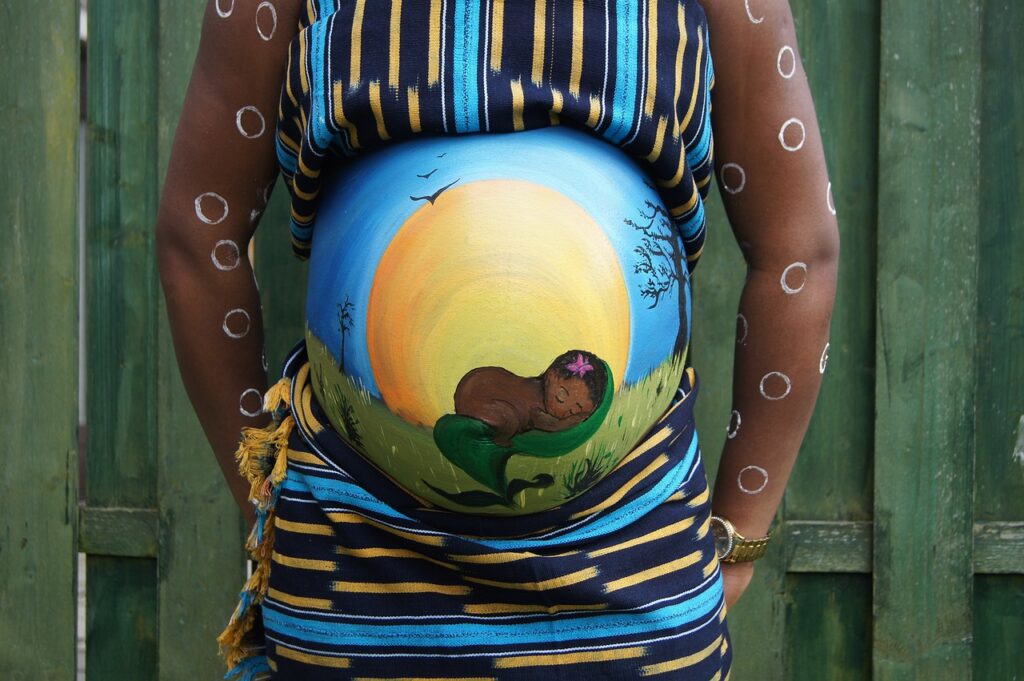Wat betekent Darwin’s ‘aanpassing aan de leefomgeving’ voor het zich ontwikkelende brein? Hoe meer stress tijdens de zwangerschap, hoe angstiger en depressiever de kinderen zich later gaan voelen (35).

De hersenen van een baby ontwikkelen zich in razend tempo. Van een omvang van ongeveer 400 mL bij de geboorte groeien ze naar 1.000 mL op 2-jarige leeftijd en daarna tot maximaal 1.200 mL (vrouwen) en 1.300 mL (mannen) (1-3). Neuronen maken in het begin van het leven duizelingwekkende aantallen verbindingen met elkaar. Worden deze niet benut, dan verdwijnen ze tussen het 2e en 16e levensjaar (4,4a). Niet onverwacht zijn de hersenen van jonge mensen uitermate gevoelig voor ‘verstoringen’ die op latere leeftijd linken aan ‘psychiatrische’ ziektebeelden, zoals autisme (5-13) en schizofrenie (8,14-24).
Het lastige van deze ziektes (25-32) is dat ze in het lichaam (nog) niet ‘meetbaar’ zijn. Daardoor veranderen de definities en diagnostische criteria nogal eens (33,34). In de nieuwste versie van de DSM – het diagnostisch handboek van de psychiatrie – zijn in 2022 vier vormen van autisme samengevoegd tot ‘autisme spectrum stoornis’ en werden nieuwe vormen van depressie, waaronder ‘premenstruele dysfore stoornis’, aan het arsenaal toegevoegd (34). Populaire opvattingen zorgen voor een ongebreidelde groei aan ADHD’ers en narcisten, die vroeger gewoon ‘druk’ of ‘ambitieus’ werden genoemd.
Wetenschappers die dit onderwerp louter biologisch benaderen, treffen een immens gebied van tinten grijs. Hoe het menselijk brein vanaf het levensbegin ‘geprogrammeerd’ raakt aan de omstandigheden, is al tien jaar bekend. Centraal zijn hierbij het stresshormoon cortisol en de amygdala, de amandelvormige kern die betrokken is bij het aansturen en verwerken van emoties, zoals agressie en angst (41,42). Uit een meerjarig onderzoek bleek: hoe hoger het cortisolniveau in de zwangere moeder, hoe omvangrijker de amygdala en hoe meer ‘gevoelsproblemen’ bij hun dochters van 7 jaar (35).
Een betrokken, zorgzame moeder is de jackpot
Van dieren was dit al eerder bekend (43-54c). Zoals uit onderzoek van pasgeboren babyratjes blijkt. Baby’s van een zorgzame moederrat die haar baby’s continu likte, werden omgewisseld met baby’s uit het nest van een moeder die slechts het hoogst noodzakelijke deed. Ratjes met de verzorgende moeder hadden de jackpot, ook al was het niet hun biologische moeder. Bij hen werden meer glucocorticoïd receptoren in de hippocampus aangelegd dan bij het nageslacht dat door een ‘onverschillige’ moeder werd grootgebracht (49). Zo moeder, zo dochter? Ja, maar het betrof niet de genetische (maar epigenetische) eigenschappen! Het kroost dat ‘groot’ werd bij een afstandelijke moeder gedroeg zich later ook angstig en koel tegenover hun eigen nageslacht, hoewel hun biologische moeder zorgzaam was.
Ook bij aanstaande mensenmoeders zijn gevoelens van stress, depressie en angst gelinkt aan gedragsproblemen en het denkvermogen van hun nageslacht (46). Kinderen van moeders die tijdens de zwangerschap werden behandeld met een synthetische vorm van cortisol hadden op 6-10 jarige leeftijd een dunnere hersencortex en meer ‘affectieve’ problemen (54b,54c). Stress tijdens de zwangerschap bestookt het brein in wording met cortisol waardoor het ongeboren kind onbewust wordt geprogrammeerd voor een overlevingsstrategie met meer angst en agressie (43-46,55,62).
Dierproeven tonen dat je de hersenen in de baarmoeder kunt programmeren tot die van een havik maar ook tot die van een duif (62). Op moleculair niveau ligt de programmering in de ‘epigenetica’ en daarom is deze in principe ook te ‘herstellen’. Vooralsnog echter is ‘epigenetische herprogrammering’ zonder verstoring van andere programma’s (64-67) een even grote uitdaging als het specifiek doden van een kankercel.
Afbeelding van AnoukvanMarsbergen via Pixabay
Brain growth
1. Widdowson EM. Growth and body composition in childhood. Clinical Nutrition of the Young Child Nestle 1985, pp1-16.
2. Smithsonian National Museum of Natural History. Human Characteristics: What Does it Mean to be Human: Brains Bigger Brains: Complex Brains for a Complex World
https://humanorigins.si.edu/human-characteristics/brains
3. Bethlehem RAI et al. Brain charts for the human lifespan. Nature. 2022 Apr;604(7906):525-533. doi: 10.1038/s41586-022-04554-y. Epub 2022 Apr 6. Erratum in: Nature. 2022 Oct;610(7931):E6. PMID: 35388223; PMCID: PMC9021021.
https://pubmed.ncbi.nlm.nih.gov/35388223/
Brain development
4. Brotherson, S. E. (2005). Understanding brain development in young children. Fargo, ND: NDSU Extension Service.
https://library.ndsu.edu/ir/handle/10365/4954
4a. Caffaso J. What Is Synaptic Pruning? Updated on September 18, 2018. Accessed 2 January 2023
https://www.healthline.com/health/synaptic-pruning
Autism
5. Glasson EJ, Bower C, Petterson B, de Klerk N, Chaney G, Hallmayer JF. Perinatal factors and the development of autism: a population study. Arch Gen Psychiatry. 2004 Jun;61(6):618-27. doi: 10.1001/archpsyc.61.6.618. PMID: 15184241.
https://pubmed.ncbi.nlm.nih.gov/15184241/
6. Larsson HJ, Eaton WW, Madsen KM, Vestergaard M, Olesen AV, Agerbo E, Schendel D, Thorsen P, Mortensen PB. Risk factors for autism: perinatal factors, parental psychiatric history, and socioeconomic status. Am J Epidemiol. 2005 May 15;161(10):916-25; discussion 926-8. doi: 10.1093/aje/kwi123. PMID: 15870155.
https://pubmed.ncbi.nlm.nih.gov/15870155/
7. Maimburg RD, Vaeth M. Perinatal risk factors and infantile autism. Acta Psychiatr Scand. 2006 Oct;114(4):257-64. doi: 10.1111/j.1600-0447.2006.00805.x. PMID: 16968363.
https://pubmed.ncbi.nlm.nih.gov/16968363/
8. Meyer U, Feldon J, Dammann O. Schizophrenia and autism: both shared and disorder-specific pathogenesis via perinatal inflammation? Pediatr Res. 2011 May;69(5 Pt 2):26R-33R. doi: 10.1203/PDR.0b013e318212c196. PMID: 21289540; PMCID: PMC3086802.
https://pubmed.ncbi.nlm.nih.gov/21289540/
9. Getahun D, Fassett MJ, Peltier MR, Wing DA, Xiang AH, Chiu V, Jacobsen SJ. Association of Perinatal Risk Factors with Autism Spectrum Disorder. Am J Perinatol. 2017 Feb;34(3):295-304. doi: 10.1055/s-0036-1597624. Epub 2017 Jan 31. PMID: 28099978.
https://pubmed.ncbi.nlm.nih.gov/28099978/
10. Talmi Z, Mankuta D, Raz R. Birth weight and autism spectrum disorder: A population-based nested case-control study. Autism Res. 2020 Apr;13(4):655-665. doi: 10.1002/aur.2260. Epub 2020 Jan 13. PMID: 31930777.
https://pubmed.ncbi.nlm.nih.gov/31930777/
11. Majerczyk D, Ayad EG, Brewton KL, Saing P, Hart PC. Systemic maternal inflammation promotes ASD via IL-6 and IFN-γ. Biosci Rep. 2022 Nov 30;42(11):BSR20220713. doi: 10.1042/BSR20220713. PMID: 36300375; PMCID: PMC9670245.
https://pubmed.ncbi.nlm.nih.gov/36300375/
12. Chang YS, Chen LW, Yu T, Lin SH, Kuo PL. Preterm birth and weight-for-gestational age for risks of autism spectrum disorder and intellectual disability: A nationwide population-based cohort study. J Formos Med Assoc. 2022 Nov 9:S0929-6646(22)00389-8. doi: 10.1016/j.jfma.2022.10.005. Epub ahead of print. PMID: 36371297.
https://pubmed.ncbi.nlm.nih.gov/36371297/
13. Yang Y, Shen Y, Lin J, Dai S, Lu X, Xun G, Li Y, Wu R, Xia K, Luo X, Zhao J, Ou J. Association between history of miscarriage and autism spectrum disorder. Eur Arch Psychiatry Clin Neurosci. 2022 Oct 17. doi: 10.1007/s00406-022-01494-6. Epub ahead of print. PMID: 36251093.
https://pubmed.ncbi.nlm.nih.gov/36251093/
Schizophrenia
14. Torrey EF, Miller J, Rawlings R, Yolken RH. Seasonality of births in schizophrenia and bipolar disorder: a review of the literature. Schizophr Res. 1997 Nov 7;28(1):1-38. doi: 10.1016/s0920-9964(97)00092-3. PMID: 9428062.
https://pubmed.ncbi.nlm.nih.gov/9428062/
15. Wahlbeck K, Forsén T, Osmond C, Barker DJ, Eriksson JG. Association of schizophrenia with low maternal body mass index, small size at birth, and thinness during childhood. Arch Gen Psychiatry. 2001 Jan;58(1):48-52. doi: 10.1001/archpsyc.58.1.48. PMID: 11146757.
https://pubmed.ncbi.nlm.nih.gov/11146757/
16. Smith GN, Flynn SW, McCarthy N, Meistrich B, Ehmann TS, MacEwan GW, Altman S, Kopala LC, Honer WG. Low birthweight in schizophrenia: prematurity or poor fetal growth? Schizophr Res. 2001 Mar 1;47(2-3):177-84. doi: 10.1016/s0920-9964(00)00004-9. PMID: 11278135.
https://pubmed.ncbi.nlm.nih.gov/11278135/
17. Cannon M, Jones PB, Murray RM. Obstetric complications and schizophrenia: historical and meta-analytic review. Am J Psychiatry. 2002 Jul;159(7):1080-92. doi: 10.1176/appi.ajp.159.7.1080. PMID: 12091183.
https://pubmed.ncbi.nlm.nih.gov/12091183/
18. St Clair D, Xu M, Wang P, Yu Y, Fang Y, Zhang F, Zheng X, Gu N, Feng G, Sham P, He L. Rates of adult schizophrenia following prenatal exposure to the Chinese famine of 1959-1961. JAMA. 2005 Aug 3;294(5):557-62. doi: 10.1001/jama.294.5.557. PMID: 16077049.
https://pubmed.ncbi.nlm.nih.gov/16077049/
19. Clarke MC, Harley M, Cannon M. The role of obstetric events in schizophrenia. Schizophr Bull. 2006 Jan;32(1):3-8. doi: 10.1093/schbul/sbj028. Epub 2005 Nov 23. PMID: 16306181; PMCID: PMC2632192.
https://pubmed.ncbi.nlm.nih.gov/16306181/
20. Byrne M, Agerbo E, Bennedsen B, Eaton WW, Mortensen PB. Obstetric conditions and risk of first admission with schizophrenia: a Danish national register based study. Schizophr Res. 2007 Dec;97(1-3):51-9. doi: 10.1016/j.schres.2007.07.018. Epub 2007 Aug 31. PMID: 17764905.
https://pubmed.ncbi.nlm.nih.gov/17764905/
21. Brown AS. The environment and susceptibility to schizophrenia. Prog Neurobiol. 2011 Jan;93(1):23-58. doi: 10.1016/j.pneurobio.2010.09.003. Epub 2010 Oct 16. PMID: 20955757; PMCID: PMC3521525.
https://pubmed.ncbi.nlm.nih.gov/20955757/
22. Wegelius A, Tuulio-Henriksson A, Pankakoski M, Haukka J, Lehto U, Paunio T, Lönnqvist J, Suvisaari J. An association between high birth weight and schizophrenia in a Finnish schizophrenia family study sample. Psychiatry Res. 2011 Dec 30;190(2-3):181-6. doi: 10.1016/j.psychres.2011.05.035. Epub 2011 Jun 12. PMID: 21664700.
https://pubmed.ncbi.nlm.nih.gov/21664700/
23. Suvisaari JM, Taxell-Lassas V, Pankakoski M, Haukka JK, Lönnqvist JK, Häkkinen LT. Obstetric complications as risk factors for schizophrenia spectrum psychoses in offspring of mothers with psychotic disorder. Schizophr Bull. 2013 Sep;39(5):1056-66. doi: 10.1093/schbul/sbs109. Epub 2012 Sep 20. PMID: 23002182; PMCID: PMC3756781.
https://pubmed.ncbi.nlm.nih.gov/23002182/
24. Forsyth JK, Ellman LM, Tanskanen A, Mustonen U, Huttunen MO, Suvisaari J, Cannon TD. Genetic risk for schizophrenia, obstetric complications, and adolescent school outcome: evidence for gene-environment interaction. Schizophr Bull. 2013 Sep;39(5):1067-76. doi: 10.1093/schbul/sbs098. Epub 2012 Sep 1. PMID: 22941745; PMCID: PMC3756777.
https://pubmed.ncbi.nlm.nih.gov/22941745/
Definition psychiatric disease
25. Dubrovsky B. Evolutionary psychiatry. Adaptationist and nonadaptationist conceptualizations. Prog Neuropsychopharmacol Biol Psychiatry. 2002 Jan;26(1):1-19. doi: 10.1016/s0278-5846(01)00243-3. PMID: 11853097.
https://pubmed.ncbi.nlm.nih.gov/11853097/
26. Polimeni J, Reiss JP. Evolutionary perspectives on schizophrenia. Can J Psychiatry. 2003 Feb;48(1):34-9. doi: 10.1177/070674370304800107. PMID: 12635562.
https://pubmed.ncbi.nlm.nih.gov/12635562/
27. Allen NB, Badcock PB. Darwinian models of depression: a review of evolutionary accounts of mood and mood disorders. Prog Neuropsychopharmacol Biol Psychiatry. 2006 Jul;30(5):815-26. doi: 10.1016/j.pnpbp.2006.01.007. Epub 2006 Apr 27. PMID: 16647176.
https://pubmed.ncbi.nlm.nih.gov/16647176/
28. Baptista T, Aldana E, Angeles F, Beaulieu S. Evolution theory: an overview of its applications in psychiatry. Psychopathology. 2008;41(1):17-27. doi: 10.1159/000109951. Epub 2007 Oct 18. PMID: 17952017.
https://pubmed.ncbi.nlm.nih.gov/17952017/
29. Burns JK. Reconciling ’the new epidemiology’ with an evolutionary genetic basis for schizophrenia. Med Hypotheses. 2009 Mar;72(3):353-8. doi: 10.1016/j.mehy.2008.09.046. Epub 2008 Nov 22. PMID: 19028022.
https://pubmed.ncbi.nlm.nih.gov/19028022/
30. Hendrie CA, Pickles AR. Depression as an evolutionary adaptation: implications for the development of preclinical models. Med Hypotheses. 2009 Mar;72(3):342-7. doi: 10.1016/j.mehy.2008.09.053. Epub 2009 Jan 18. PMID: 19153014.
https://pubmed.ncbi.nlm.nih.gov/19153014/
31. Bagot RC, Labonté B, Peña CJ, Nestler EJ. Epigenetic signaling in psychiatric disorders: stress and depression. Dialogues Clin Neurosci. 2014 Sep;16(3):281-95. doi: 10.31887/DCNS.2014.16.3/rbagot. PMID: 25364280; PMCID: PMC4214172.
https://pubmed.ncbi.nlm.nih.gov/25364280/
32. Scheepers FE, de Mul J, Boer F, Hoogendijk WJ. Psychosis as an Evolutionary Adaptive Mechanism to Changing Environments. Front Psychiatry. 2018 Jun 5;9:237. doi: 10.3389/fpsyt.2018.00237. PMID: 29922188; PMCID: PMC5996757.
https://pubmed.ncbi.nlm.nih.gov/29922188/
Changing Diagnostic and Statistical Manual of Mental Disorders (DSM)
33. PsychCentral. What Is the DSM-5? Resource Guide, Accessed 17 December 2022
https://psychcentral.com/lib/dsm-5
34. The American Psychiatry. Association. Highlights of Changes from DSM-IV-TR to DSM-5. Accessed 17 December 2022
Maternal stress, cortisol, amygdala and affective disorders
40. Maternal cortisol over the course of pregnancy and subsequent child amygdala and hippocampus volumes and affective problems_Buss Proc Natl Acad Sci U S A. 2012
https://pubmed.ncbi.nlm.nih.gov/22529357/
Limbic system, aggression, anxiety
41. Queensland Brain Institute. The limbic system. Accessed 17 December 2022
42. Neumann ID, Veenema AH, Beiderbeck DI. Aggression and anxiety: social context and neurobiological links. Front Behav Neurosci. 2010 Mar 30;4:12. doi: 10.3389/fnbeh.2010.00012. PMID: 20407578; PMCID: PMC2854527.
https://www.ncbi.nlm.nih.gov/pmc/articles/PMC2854527/
Reviews brain programming
43. Hunter RG. Epigenetic effects of stress and corticosteroids in the brain. Front Cell Neurosci. 2012 Apr 19;6:18. doi: 10.3389/fncel.2012.00018. PMID: 22529779; PMCID: PMC3329877.
https://www.ncbi.nlm.nih.gov/pmc/articles/PMC3329877/
43a. Coussons-Read ME. Effects of prenatal stress on pregnancy and human development: mechanisms and pathways. Obstet Med. 2013 Jun;6(2):52-57. doi: 10.1177/1753495X12473751. Epub 2013 May 3. PMID: 27757157; PMCID: PMC5052760.
https://www.ncbi.nlm.nih.gov/pmc/articles/PMC5052760/
44. Lee RS, Sawa A. Environmental stressors and epigenetic control of the hypothalamic-pituitary-adrenal axis. Neuroendocrinology. 2014;100(4):278-87. doi: 10.1159/000369585. Epub 2014 Nov 18. PMID: 25427939; PMCID: PMC4428760.
https://pubmed.ncbi.nlm.nih.gov/25427939/
44a. Molenaar NM, Tiemeier H, van Rossum EFC, Hillegers MHJ, Bockting CLH, Hoogendijk WJG, van den Akker EL, Lambregtse-van den Berg MP, El Marroun H. Prenatal maternal psychopathology and stress and offspring HPA axis function at 6 years. Psychoneuroendocrinology. 2019
https://pubmed.ncbi.nlm.nih.gov/30223193/
44b. Lautarescu A, Craig MC, Glover V. Prenatal stress: Effects on fetal and child brain development. Int Rev Neurobiol. 2020;150:17-40. doi: 10.1016/bs.irn.2019.11.002. Epub 2019 Dec 14. PMID: 32204831.
https://pubmed.ncbi.nlm.nih.gov/32204831/
44c. Mbiydzenyuy NE, Hemmings SMJ, Qulu L. Prenatal maternal stress and offspring aggressive behavior: Intergenerational and transgenerational inheritance. Front Behav Neurosci. 2022 Sep 23;16:977416. doi: 10.3389/fnbeh.2022.977416. PMID: 36212196; PMCID: PMC9539686.
https://pubmed.ncbi.nlm.nih.gov/36212196/
45. Makris G, Eleftheriades A, Pervanidou P. Early Life Stress, Hormones and Neurodevelopmental Disorders. Horm Res Paediatr. 2022 Mar 8. doi: 10.1159/000523942. Epub ahead of print. PMID: 35259742.
https://pubmed.ncbi.nlm.nih.gov/35259742/
46. van den Heuvel, M. I. (2022). From the Womb into the World: Protecting the Fetal Brain from Maternal Stress During Pregnancy. Policy Insights from the Behavioral and Brain Sciences, 9(1), 96-103.
https://journals.sagepub.com/doi/full/10.1177/23727322211068024
Animal licking-grooming experiment
47. Champagne FA, Francis DD, Mar A, Meaney MJ. Variations in maternal care in the rat as a mediating influence for the effects of environment on development. Physiol Behav. 2003 Aug;79(3):359-71. doi: 10.1016/s0031-9384(03)00149-5. PMID: 12954431.
https://pubmed.ncbi.nlm.nih.gov/12954431/
48. Zhang TY, Meaney MJ. Epigenetics and the environmental regulation of the genome and its function. Annu Rev Psychol. 2010;61:439-66, C1-3. doi: 10.1146/annurev.psych.60.110707.163625. PMID: 19958180.
https://pubmed.ncbi.nlm.nih.gov/19958180/
49. Weaver IC, Cervoni N, Champagne FA, D’Alessio AC, Sharma S, Seckl JR, Dymov S, Szyf M, Meaney MJ. Epigenetic programming by maternal behavior. Nat Neurosci. 2004 Aug;7(8):847-54. doi: 10.1038/nn1276. Epub 2004 Jun 27. PMID: 15220929.
https://pubmed.ncbi.nlm.nih.gov/15220929/
50. Gross C, Hen R. The developmental origins of anxiety. Nat Rev Neurosci. 2004 Jul;5(7):545-52. doi: 10.1038/nrn1429. PMID: 15208696.
https://pubmed.ncbi.nlm.nih.gov/15208696/
51. Champagne FA. Epigenetic mechanisms and the transgenerational effects of maternal care. Front Neuroendocrinol. 2008 Jun;29(3):386-97. doi: 10.1016/j.yfrne.2008.03.003. Epub 2008 Mar 28. PMID: 18462782; PMCID: PMC2682215.
https://pubmed.ncbi.nlm.nih.gov/18462782/
52. Krishnan V, Nestler EJ. The molecular neurobiology of depression. Nature. 2008 Oct 16;455(7215):894-902. doi: 10.1038/nature07455. PMID: 18923511; PMCID: PMC2721780.
https://pubmed.ncbi.nlm.nih.gov/18923511/
53. Youngson NA, Whitelaw E. Transgenerational epigenetic effects. Annu Rev Genomics Hum Genet. 2008;9:233-57. doi: 10.1146/annurev.genom.9.081307.164445. PMID: 18767965.
https://pubmed.ncbi.nlm.nih.gov/18767965/
54. van der Knaap LJ, Riese H, Hudziak JJ, Verbiest MM, Verhulst FC, Oldehinkel AJ, van Oort FV. Glucocorticoid receptor gene (NR3C1) methylation following stressful events between birth and adolescence. The TRAILS study. Transl Psychiatry. 2014 Apr 8;4(4):e381. doi: 10.1038/tp.2014.22. PMID: 24713862; PMCID: PMC4012286.
https://pubmed.ncbi.nlm.nih.gov/24713862/
54a. Manuela Z, Julien P, Elodie B, Olivier B, Jérôme M. Glucocorticosteroids Effects on Brain Development in the Preterm Infant: A Role for Microglia? Curr Neuropharmacol. 2021;19(12):2188-2204. doi: 10.2174/1570159X19666210517112913. PMID: 33998994; PMCID: PMC9185757.
https://pubmed.ncbi.nlm.nih.gov/33998994/
54b. Dumas TC. Adult Health and Early Life Adversity: Behind the Curtains of Maternal Care Research. Front Physiol. 2022 Mar 3;13:804239. doi: 10.3389/fphys.2022.804239. PMID: 35309057; PMCID: PMC8928269.
https://pubmed.ncbi.nlm.nih.gov/35309057/
54c. Davis EP, Sandman CA, Buss C, Wing DA, Head K. Fetal glucocorticoid exposure is associated with preadolescent brain development. Biol Psychiatry. 2013 Nov 1;74(9):647-55. doi: 10.1016/j.biopsych.2013.03.009. Epub 2013 Apr 21. PMID: 23611262; PMCID: PMC3985475.
https://pubmed.ncbi.nlm.nih.gov/23611262/
Evolutionary explanation
55. Cameron NM, Shahrokh D, Del Corpo A, Dhir SK, Szyf M, Champagne FA, Meaney MJ. Epigenetic programming of phenotypic variations in reproductive strategies in the rat through maternal care. J Neuroendocrinol. 2008 Jun;20(6):795-801. doi: 10.1111/j.1365-2826.2008.01725.x. Epub 2008 Jun 1. PMID: 18513204.
https://pubmed.ncbi.nlm.nih.gov/18513204/
High incidence of low birth weight and heart disease in south USA
56. Kuzawa CW, Sweet E. Epigenetics and the embodiment of race: developmental origins of US racial disparities in cardiovascular health. Am J Hum Biol. 2009 Jan-Feb;21(1):2-15. doi: 10.1002/ajhb.20822. PMID: 18925573.
https://pubmed.ncbi.nlm.nih.gov/18925573/
57. Collins JW Jr, Rankin KM, David RJ. African American women’s lifetime upward economic mobility and preterm birth: the effect of fetal programming. Am J Public Health. 2011 Apr;101(4):714-9. doi: 10.2105/AJPH.2010.195024. Epub 2011 Feb 17. PMID: 21330589; PMCID: PMC3052339.
https://pubmed.ncbi.nlm.nih.gov/21330589/
58. Centers for Disease Control and Prevention (CDC). Mobidity and Mortality Weekly Report. Supplement / Vol. 60 January 14, 2011, Accessed 17 December 2022
https://www.cdc.gov/mmwr/pdf/other/su6001.pdf
59. March of Dimes Premature Birth Report Card grades cities; focuses on racial disparities. WHITE PLAINS, N.Y., NOV. 5, 2015. Accessed 17 December 2022
https://www.eurekalert.org/news-releases/683010
The impunity brain
60. Korteweg N. Het straffeloze brein. NRC Handelsblad Magazine, 15 augustus 2009, accessed 17 December 2022
http://www.nikikorteweg.nl/projects/het-straffeloze-brein/
61. da Cunha-Bang S, Fisher PM, Hjordt LV, Perfalk E, Persson Skibsted A, Bock C, Ohlhues Baandrup A, Deen M, Thomsen C, Sestoft DM, Knudsen GM. Violent offenders respond to provocations with high amygdala and striatal reactivity. Soc Cogn Affect Neurosci. 2017 May 1;12(5):802-810. doi: 10.1093/scan/nsx006. PMID: 28338916; PMCID: PMC5460055.
https://pubmed.ncbi.nlm.nih.gov/28338916/
61a. Haller J. Aggression, Aggression-Related Psychopathologies and Their Models. Front Behav Neurosci. 2022 Jul 4;16:936105. doi: 10.3389/fnbeh.2022.936105. PMID: 35860723; PMCID: PMC9289268.
https://pubmed.ncbi.nlm.nih.gov/35860723/
The brain of the hawk and the dove
62. Korte SM, Koolhaas JM, Wingfield JC, McEwen BS. The Darwinian concept of stress: benefits of allostasis and costs of allostatic load and the trade-offs in health and disease. Neurosci Biobehav Rev. 2005 Feb;29(1):3-38. doi: 10.1016/j.neubiorev.2004.08.009. Epub 2004 Dec 10. PMID: 15652252.
https://pubmed.ncbi.nlm.nih.gov/15652252/
Offspring of Holocaust survivors
63. Dashorst P, Mooren TM, Kleber RJ, de Jong PJ, Huntjens RJC. Intergenerational consequences of the Holocaust on offspring mental health: a systematic review of associated factors and mechanisms. Eur J Psychotraumatol. 2019 Aug 30;10(1):1654065. doi: 10.1080/20008198.2019.1654065. PMID: 31497262; PMCID: PMC6720013.
https://pubmed.ncbi.nlm.nih.gov/31497262/
Epigenetic therapies for mental disorders
64. Peedicayil J. The Potential Role of Epigenetic Drugs in the Treatment of Anxiety Disorders. Neuropsychiatr Dis Treat. 2020 Mar 2;16:597-606. doi: 10.2147/NDT.S242040. PMID: 32184601; PMCID: PMC7060022.
https://pubmed.ncbi.nlm.nih.gov/32184601/
65. Basu A, Tiwari VK. Epigenetic reprogramming of cell identity: lessons from development for regenerative medicine. Clin Epigenetics. 2021 Jul 23;13(1):144. doi: 10.1186/s13148-021-01131-4. PMID: 34301318; PMCID: PMC8305869.
https://pubmed.ncbi.nlm.nih.gov/34301318/
66. Toth M. Epigenetic Neuropharmacology: Drugs Affecting the Epigenome in the Brain. Annu Rev Pharmacol Toxicol. 2021 Jan 6;61:181-201. doi: 10.1146/annurev-pharmtox-030220-022920. Epub 2020 Sep 30. PMID: 32997604.
https://pubmed.ncbi.nlm.nih.gov/32997604/
67. Epigenetic Therapies for Treatment of Mental Disorders. Structure-Based Design. By Contributor Published On: February 8, 2019. Last Updated: November 14, 2022 Accessed 2 January 2023
https://ftloscience.com/epigenetic-therapies-mental-disorders/
MMV maakt wekelijks een selectie uit het nieuws over voeding en leefstijl in relatie tot kanker en andere medische condities.
Inschrijven nieuwsbrief








